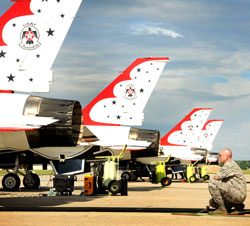The U.S. Air Force Thunderbirds became the first Department of Defense aerial team to use alternative fuel during a Joint Services Open House on Friday.
 According to Sustainable Oils, hydrotreated renewable jet fuel (HRJ) made from its camelina powered two Air Force F-16 aircraft for the flight. The camelina was grown and harvested in Montana, and refined into renewable jet using technology from UOP, a Honeywell company.
According to Sustainable Oils, hydrotreated renewable jet fuel (HRJ) made from its camelina powered two Air Force F-16 aircraft for the flight. The camelina was grown and harvested in Montana, and refined into renewable jet using technology from UOP, a Honeywell company.
The fuel was a blend of 50 percent camelina-based biofuel and 50 percent regular Jet Propellant 8 fuel. The Air Force has tested and certified biofuel as a 50-percent blend with regular jet fuel in the A-10 Thunderbolt II, the F-15 Eagle, the C-17 Globemaster III, and the F-22 Raptor to date. Air Force officials have stated that fleetwide certification is on track for completion in 2013. Sustainable Oils has provided nearly 500,000 gallons of camelina-based HRJ to multiple branches of the US military for its certification programs, making it the most heavily tested alternative fuel feedstock. They are also testing biomass fuels derived from beef tallow and various waste oils and greases.
The Air Force is the largest user of energy in the Department of Defense, said Undersecretary of the Air Force Erin Conaton said during the Friday open house, burning more than two billion gallons of aviation fuel each year. “Right now, biomass fuel is about 10 times the cost of JP-8, the current military aviation jet fuel in use,” Conaton said. “In these days of constricted budgets, the fuel the Air Force will buy needs to be cost competitive. When the biofuel industry is able to provide the quantity of fuel the Air Force requires at a good price, we will be ready to buy from them.”
Today at Wright Patterson Air Force base in Ohio, the Air Force is opening a center for ongoing research efforts to develop alternative jet fuels including those derived from coal, algae or biomass sources such as energy crops and waste material.

